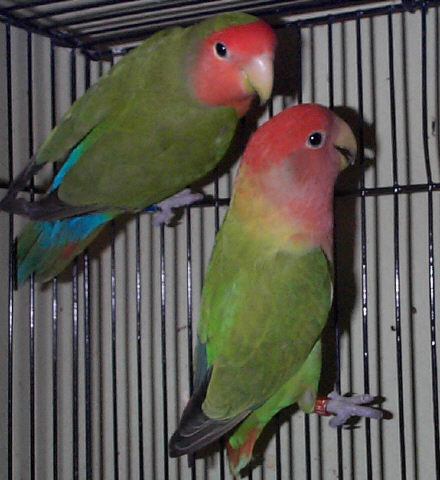OPALINE MUTATION IN PEACHFACE LOVEBIRDS

Opaline is a very new mutation in peachface lovebirds. It was discoved
in 1997. There had been many mutations in peachface lovebirds previously,
but they all
created new color combinations except for the pied mutation, which
creates irregular colored areas on the bird. The opaline mutation changes where the colors are located on the birds
in a predictable but new pattern. Not surprisingly, it's therefore
called a "pattern" mutation. Opaline mutations also exist in other
birds, but
this particular opaline mutation is especially interesting because it's the
first found in a non-Australian bird. It's
truly a very unusual event in the history of aviculture.
The bird on the left in the photo has the "normal" pattern of colors for a
green Peachface Lovebird. The peach color of the face extends onto the
forehead but no further. The rump is blue, and there's very little red
on the tailfeathers. This pattern holds true for color combinations other
than the green variety of birds.
The bird on the right is an opaline. The entire head is colored in
shades related to the face color, except for a small patch over each
ear. The rump is the same color as the back, and there is a large
amount of red on the tail feathers. The edges of the feathers are
lighter than in non-opaline birds, creating a subtle marbling effect. It almost looks like a new
species.
The opaline mutation is sex linked. As a result, hens with opaline
genes will always show the pattern (they are termed "visuals"). Males
require two copies of the gene to be visuals, so there are far fewer
of them. We have noticed subtle differences in males with only one
copy of the gene ("splits") that sometimes allow a breeder to tell the
difference between a split male and one that has no opaline gene at
all.
THE OPALINE STORY
The opaline mutation first appeared in peachface lovebirds bred by Becky Anderson
of the Royal Rose Aviary in Upper Michigan in January, 1997. We met Becky at a
bird fair in Oshkosh, Wisconsin, in April 1998 when Royan noticed her at the show. Becky
was wearing a shirt with pictures of lovebirds the likes of which we'd
never seen! They started talking, and it became obvious she had
something unlike any lovebird that had existed previously.
Becky had not had much luck getting the attention of the African
Lovebird Society. Though we were new to breeding lovebirds,
we knew some members we thought could help the birds
become recognized for what they were, and introduced Becky to Doug
Bedwell, a well known and much respected breeder of lovebirds.
Working together, Brad took some new photographs, Doug wrote an article
for the Society's journal, and we all ensured ALBS bird show
judges got to see the birds at regional shows. The first of these was
in June, 1998, in Appleton, Wisconsin. In November, 1998, we all
attended the national convention of the ALBS in a Chicago suburb where
the birds were introduced to the world in general. Interest was
intense. A year later, a naming committee of the ALBS awarded them the
name opaline (we had been calling them "Roseheads" or "Rosies" up until that
point.) By then, there were breeders in several locations
working with the birds, ensuring the survival of a very beautiful and
very unusual variety of lovebird. The race is now on to see who can
come up with opalines in the various color combinations available in
the non-opaline peachface lovebirds. We're finding there are lots of
surprises in how the colors interact. You can see some of these new
combinations in our photo gallery. Each new combination is proving
an adventure for opaline breeders.
Back to the Aviary Home Page
